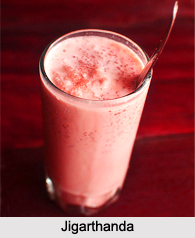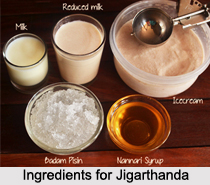 Jigarthanda is a South Indian beverage originated in Madurai, Tamil Nadu. In Hindi, "Jigarthanda" translates to "Cool Heart". It is generally prepared and served by road side pull-ins in Madurai as a refreshment drink during the Indian summer. This unique flavored milk based drink was introduced by the Mughals and named Jigarthanda. Popular as "Jil Jil jigarthanda", this drink has made its way too many restaurants and drink parlours around Tamil Nadu. The ingredients that go into the making of the Jigarthanda drink recipe have a cooling effect on the system and are a close cousin of Falooda drink which has varied textures and flavors.
Jigarthanda is a South Indian beverage originated in Madurai, Tamil Nadu. In Hindi, "Jigarthanda" translates to "Cool Heart". It is generally prepared and served by road side pull-ins in Madurai as a refreshment drink during the Indian summer. This unique flavored milk based drink was introduced by the Mughals and named Jigarthanda. Popular as "Jil Jil jigarthanda", this drink has made its way too many restaurants and drink parlours around Tamil Nadu. The ingredients that go into the making of the Jigarthanda drink recipe have a cooling effect on the system and are a close cousin of Falooda drink which has varied textures and flavors.
Preparation of Jigarthanda
The main ingredients of Jigarthanda recipe are reduced full fat milk, reduced milk ice cream and two natural coolants that are Badam Pisin, which is a special edible almond gum that is taken from almond tree and Nannari Syrup. Badam Pisin has a lot of medicinal properties and has very cooling effect on the body. Nannari syrup is made from Sarsaparilla root, a pleasant smelling herb. This herb has medicinal properties and makes for great diuretic, cools the body and prevents heat strokes.
 Ingredients of Jigarthanda
Ingredients of Jigarthanda
Jigarthanda requires the following ingredients:
•Badam Pisin - 1 tsp (almond gum)
•Milk - 4 and 1/2 cups, full fat milk
•Nannari Syrup - 3 tbsp
•Vanilla Ice-cream - 3 scoops
•Sugar - 3 tbsp
Method of Jigarthanda
The method of making Jigarthanda is enlisted below:
•Soak Badam Pisin in 1 and 1/4 cups of water overnight. Next day, it will swell and form a transparent jelly like consistency. Remove any impurities if any.
•Bring full fat milk to a boil and reduce to almost half its original quantity.
•Turn off flame; add 3 tbsp of sugar and mix till dissolved. Bring to room temperature and chill in fridge till use
•.To assemble the drink, take 3 tall glasses.
•Add a generous tbsp of the Badam Pisin in each glass followed by a drizzle a generous tbsp of Nannari syrup
•Divide the sweetened milk among the 3 glasses till 3/4th full.
•Top with a scoop of reduced milk ice cream or store bought vanilla ice cream and serve immediately.
Tips for Jigarthanda
One can replace Nannari syrup with rose syrup/ rooh afza. One can use Agar Agar (China Grass) instead of Badam Pisin. If using Agar Agar, soak a fistful in 1/3 cup of warm sugar syrup till they form into a jelly.




















